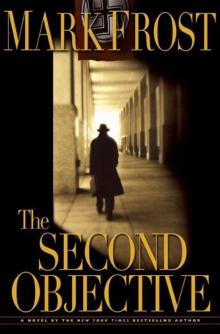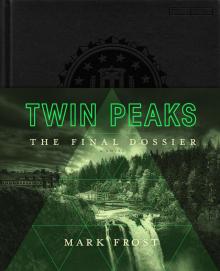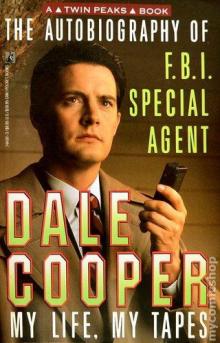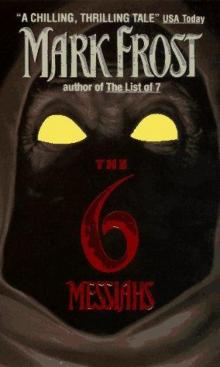- Home
- Mark Frost
Twin Peaks: The Final Dossier Page 5
Twin Peaks: The Final Dossier Read online
Page 5
First, a disclaimer: Elements of this narrative may be familiar to you from a review of Cooper’s own words on the subject culled from his daily tapes to Diane, or rather from Diane’s transcripts of the tapes. After an independent survey of all the available facts, I have concluded that the tapes/transcripts have been heavily redacted and modified—it’s safe to say that “Diane’s” motivations for doing so, at this point, are well known to us—and cannot be considered a consistently reliable source.
In the early 1980s, an investigation into a murder by a potential serial killer—which we now have strong reason to suspect was a series of killings committed by Earle himself—brought young agent Cooper to the Pittsburgh Bureau office for his first field assignment. He was soon tasked to participate in the ongoing investigation of these murders, an effort spearheaded early on by Agent Earle. We also know that Earle suspected that a mutual attraction existed between Cooper and Caroline from the moment he introduced them to each other at a Bureau Christmas party in Philadelphia the previous year. Cooper himself admitted to the attraction in his tapes, but it’s unlikely anything would have come of it had the months he spent in Pittsburgh working on this case not ensued. Although his native brilliance managed to conceal it from everyone in his life, from statements he made later while in custody, we also know there’s ample reason to suspect that by this point Windom Earle was already far down the road toward losing his mind.
So Earle not only suspected his wife and partner’s budding affinity; he perversely proceeded to do everything in his power to push them together in order to prove that it existed, thereby justifying the repellent response he was already formulating. Finding frequent excuses to work out of town, ostensibly on trips related to their ongoing investigation, Earle in fact remained in town, undercover, in order to conduct covert surveillance. He even took steps to nudge them toward each other—for example, anonymously drawing them both to the same location so they would meet “coincidentally”—acting as a deranged, vengeful Cupid. This culminated in the one ill-fated weekend they would spend as lovers, when Earle crossed the threshold from private madman to public murderer.
While the attack appeared to be a classic “crime of passion”—apparently his intention and, perhaps, what he hoped would become the foundation of his legal defense—Windom Earle didn’t count on the fact that Agent Cooper had by this time privately realized that Earle himself was the serial killer they had been chasing all along. Caroline, it seems, reached this same conclusion, also on her own, and confirmed it when she and Cooper finally examined the facts together. It’s now clear that when Earle took his wife’s life and nearly finished Cooper’s, he was acting to prevent their revealing his guilt to the Bureau. At which point this “crime of passion” became a convenient cover for our purposes, as well as his, to conceal the far uglier truth. A trial was avoided, and the truth was buried with Caroline. Either interpretation would have been more than enough to justify Earle’s confinement in a secure facility for the criminally insane, an entirely appropriate outcome. This tragedy, I also now realize, became the means through which you yourself met Agent Cooper, who in every way lived up to the hopes and ideals Windom Earle had once embodied, and so bitterly betrayed.
The level of Cooper’s suffering and remorse in the terrible aftermath of these tragic events can’t be underestimated. He fiercely committed himself to counseling and self-reflection during his physical recovery in a way that was 100 percent sincere. He’s on record—well, tape, anyway—confirming that this experience represented the most difficult lesson of his life, and, admirably, he took it to heart. But that’s not quite the same thing as entirely purging an ingrained impulse to save a troubled woman from herself, is it, Chief?
(Am I being too harsh on Agent Cooper here? I’m open to suggestions, so please let me know if you feel that’s the case. Notwithstanding its importance, I believe Cooper’s obsession with the Laura Palmer case harbors echoes of this tendency.)
So let me bring this home: Was this established trait a factor in Cooper’s attraction to Annie Blackburn? It’s possible that what drew him to Annie was something much purer and simpler: the fact that they’d both endured—and survived—vicious assaults by dangerous criminals against the core of their being, which nearly cost them their lives. That such a powerful personal narrative connected them shouldn’t be minimized. For all we know, had their relationship been given a chance to grow, it could have become the most healing bond either of them had ever experienced, possibly even (a heart breaking thought) the love of a lifetime. It’s not out of the question, and I know it must be the least of what you would have wished for your friend. Sadly, we’ll never know.
We do know that after nearly ten years in solitary lockdown at a federal max-security facility, Earle engineered a breathtakingly daring escape and vanished without a trace. We also know that, in the kind of perverse defiance he relished, he retreated to a hideout he’d previously established in the abandoned Eastern State Penitentiary, in Philadelphia, the nation’s oldest and most notorious prison for the criminally insane. From there he launched the plot for revenge he’d apparently been planning all this time.
FEDERAL BUREAU OF INVESTIGATION Field Office Criminal Investigative and Administrative Files
Earle had been in Twin Peaks for more than a month—his crime spree of murders and misdemeanors are well known to us and need not be reviewed here—when Norma and other friends at the Double R encouraged Annie Blackburn to enter a local beauty contest, the Miss Twin Peaks pageant. With typically earnest sincerity, Annie wrote a speech, which she gave in the “talent competition,” that employed standard homilies about world peace, quoted Chief Seattle, wowed the judges—a low bar, admittedly—and won the crown. At which point all hell broke loose: Under the cover of pyrotechnic distractions, Windom Earle kidnapped Annie and made off with her undetected. The trail grows hazy from this point forward.
Earle took her to a—still to this day—undiscovered location, somewhere in the Ghostwood National Forest. (Hints of a “supernatural” angle creep in here, which I’m not inclined to credit, but the Archivist’s and our own subsequent experiences with the Cooper case may justify a revisiting.) Earle’s objective seems crystal clear: With Annie in hand, he hoped to draw Cooper to him and finish the job he’d begun in Pittsburgh years earlier. Later that same night, Cooper, accompanied by two members of the Sheriff’s Department, traveled to a place in the woods where he apparently had reason to believe Earle might be holding her. Cooper “went in alone”—this according to Sheriff Truman’s account—and then “disappeared” overnight.
The difficulty is: I don’t know what he meant by either description. Went in where? Disappeared how? There’s no elaboration, and Truman has ever since remained tight-lipped about it, out of, I suppose, unswerving loyalty to his friend. But Cooper’s location and what happened to him over the next twelve hours remain stubbornly in the dark. The next morning, near dawn, Sheriff Truman and one of his deputies found Cooper and Annie in a nearby clearing. Deputies rushed Annie to a hospital. They took Cooper back to his room at the Great Northern, where Doc Hayward checked him out and pronounced him healthy but in need of rest, and Cooper spent the remainder of that day recovering at the hotel.
Windom Earle was never seen again. No trace of him, dead or alive, ever turned up in those woods or elsewhere. As you know, within a few days Cooper himself disappeared not only from Twin Peaks but from every map or grid in the Bureau’s tool kit for twenty-five years.
Annie Blackburn spent one day in the hospital, during which she appeared relatively unaffected by whatever ordeal she’d endured and claimed to have no memories of it. The next morning, hospital staff found her in an abject catatonic state. Eyes open, staring straight ahead, unseeing, pupils fixed, completely unresponsive to any visual or aural stimuli. Mystified, they could find no underlying physical explanation; her vitals were robust. She remained this way for the next ten days, during which they treated her with intravenous fl
uids and nutrition and all her vitals remained strong. At every moment, Norma or one of her friends from the diner attended her bedside. Annie’s condition slowly improved, to the point that, with assistance, she was eventually able to sit up and walk around. Her affect remained passive and compliant—serene, even—throughout. She allowed nursing staff to dress, feed, and bathe her as needed. But she never spoke again, never acknowledged anyone else’s presence, never even appeared to see or hear anyone or anything in front of her.
Two months on, Norma moved Annie back home, where she began to take care of her personally. (Knowing Norma, this hardly comes as a surprise, whereas their mother, Vivian, never even returned Norma’s calls about Annie’s condition—she’d already moved on to the next husband, where no mention of her past was welcome.) One year to the day after Annie had been found in the woods, Norma came home to find her slumped in bed, in a pool of her own blood; she’d slit her wrists again with the shards of a shattered glass. Norma discovered her just in time and rushed her to the hospital. Once again, Annie never gave the slightest indication that she knew what she’d done to herself, where she was, or whom she was with. She remained awake and alert and completely detached from her surroundings. She did, however, speak one sentence the next morning in the hospital. As far as anyone could remember, it was the only thing she’d said since the day they found her in the woods. Although there were people in the room, including Norma, no one there had spoken to her—they knew better—so she wasn’t responding to a question asked by anyone present.
“I’m fine,” she said.
They noted this on her chart: 8:38 A.M. After which, according to their records, Annie lapsed back into her impenetrable isolation and did not utter another word. The doctor on call noted this on her chart: “May have been responding to auditory hallucination.”
Annie’s condition did not improve. On the recommendation of every doctor she consulted, Norma finally acknowledged that, if she were to have any hope of carrying on the rest of her own working life, she would no longer be able to shoulder full responsibility for her sister’s care. After her second suicide attempt, Annie required around-the-clock supervision and observation. Once again, reliably, Annie’s mother, Vivian, refused all of Norma’s entreaties to help with any aspect of Annie’s condition. Within a few weeks, after a community fund-raiser helped Norma meet the burdensome financial commitment—Ben Horne, somewhat surprisingly, was a major contributor—Annie was transferred to a private psychiatric hospital near Spokane.
She’s been there ever since. I visited the hospital recently and spent more than two hours sitting with her. She’s still quite beautiful, her face unlined and youthful in appearance, peaceful in temperament, and blissfully detached from everything and everyone around her. She looks as if she’s hardly aged a day. She sits alone and still every day, all day, without any need for or interest in external stimulation or activity. Compliant and cooperative, she shows no interest in feeding herself, but never objects to being fed. Her eyes, far from appearing dull and vacant—as her condition and diagnosis would lead you to expect—seem alive, filled by a vivid and mysterious internal life. But one last anomaly jumped out at me as I examined her records and video files, and it may interest you as well, Chief.
Every year, once a year, on the anniversary of that day she was found in the woods, without prompting or responding to any inquiry directed to her, at precisely 8:38 in the morning, she speaks that same single sentence to no one in particular.
“I’m fine,” she says.
That’s the only identifiable feature I can find in an otherwise flat and featureless landscape. The doctors tell me that now, a quarter of a century on, it’s highly doubtful her condition will ever change or improve.
And so it seems, with an endless ellipsis rather than a period, here is where we take our leave of the lamentable life’s journey of Annie Blackburn.
FEDERAL BUREAU OF INVESTIGATION Field Office Criminal Investigative and Administrative Files
I want to include one curious and, perhaps, related postscript. In the aftermath of Windom Earle’s one-man crime spree, life in Twin Peaks took a considerable amount of time to return to “normal.” This detail stood out for me:
You’ll recall from Major Briggs’s dossier the story of Lana Budding Milford, the young sexual adventuress who was—for a night, anyway—married to the late Doug Milford, publisher of the Twin Peaks Post and erstwhile lifelong spook. When Annie Blackburn disappeared, reappeared, and quickly thereafter descended into her twilight state, the organizers of the pageant—after observing a respectable sixty-day interval—made an official public announcement that their elected representative would be unable to fulfill the appointed functions of her office. And, yes, as a civic position, Miss Twin Peaks does serve verifiable, if hardly profound, small-town public relations duties, along the lines of ribbon cuttings, high school homecoming games, and photo ops with visiting dignitaries.
The town council voted that, in Annie’s tragic absence, the Miss Twin Peaks runner-up would assume the title and fill the position. That was, according to the scorecards, Lana Budding Milford. The fact that in the weeks following her husband’s untimely death Lana was seen—at various times in various locations by a number of different witnesses—canoodling with Doug’s surviving brother, the town’s longtime mayor Dwayne Milford, should not be viewed as a persuasive or prejudicial factor in their decision, or so I was encouraged to believe. Comforting her elderly brother-in-law in his time of need was viewed, more charitably, as a natural expression of Lana’s ripe and abundant compassion for her fellow man. Ahem.
Although the eternal appeal of the “dark feminine” archetype continues to fascinate, that’s not the detail that interests me here, however. I came across an inventory of Doug’s possessions at the time of his death, as an addendum to the autopsy, briefly summarized here:
• Cause of death: cardiac arrest.
• Body unclothed, found in bed.
(The morning after, you’ll recall, Doug and Lana’s wedding night in the Honeymoon Suite of the Great Northern Hotel.)
• Personal accessories recovered: on the decedent’s bedside table, one Rolex watch, one jade green ring.
Okay. The wedding had taken place approximately fourteen hours earlier. The bride and groom had been observed, as tradition dictates, exchanging rings during the recital of their vows by a roomful of witnesses. I looked into this. Although the ceremony is more than twenty-five years removed, not one of the fifteen or so attendees I interviewed recalls the ring that Lana gave to Doug as a “jade green ring,” but instead identified it as a conventional unadorned gold wedding band. I had this confirmed by the town jeweler, still in business, who was able to provide a receipt showing that Doug Milford himself had bought both his and his wife’s bands a few days before the nuptials.
When I inquired as to the disposition of the “jade green ring” postmortem, I was told that, per department protocol, it would have been returned to the widow Milford.
(To refresh your memory, there is a thread running throughout the dossier about an appearing and, apparently, disappearing “green ring.” It’s mentioned a number of times, as early as the papers of Meriwether Lewis and as late as the Nixon White House, where Doug Milford himself may have observed it on the left hand of the troubled late president. The wearer is more than a few times described as “worrying” the ring, twisting it on his or her finger, and, more often than not, its appearance presages impending peril, misfortune, or untimely death. I confess I do not know what to make of this at all and wonder if you do.)
Lana, as previously noted, lingered in Twin Peaks just long enough after Doug’s demise for probate to certify the conditions of the will, at which point she quickly split the scene on the wings of a multimillion-dollar windfall. She shows up next in the Hamptons, on the arms of an ascending line of decorative male escorts, until she snags a hedge fund manager well on his way to banking his first billion. (Remember, this was the mid-ni
neties, when authentic New York City billionaires remained a genuinely rare breed.)
On her way up the plutocratic food chain, Lana briefly dated a notorious resident of a certain eponymous tower on Fifth Avenue, who was either between wives, stepping out, or merely window-shopping. I was able to locate one society-page photograph of the duo at some charity gala, in which the man appears to be wearing an unusual green ring on his left ring finger, but the resolution of the shot proved insufficient for closer examination. In any case, their relationship was short-lived. As this was near the nadir of the man’s whizbang financial exploits—rife with bankruptcies, noxious litigations, and other related derring-do—one suspects that the ever resourceful Lana may have managed to finagle a peek at the man’s bottom line and decided she should chum neighboring waters for bigger fish. Gee, wonder what ever happened to that guy.
The man she eventually married, by the way, bested Doug Milford’s matrimonial stamina by a substantial margin, as the happy couple lived in wedded bliss all the way until 2008, when the mogul dropped dead of a heart attack in Antigua—the location of their “winter palace”—during his morning jog on the beach. Once again, the widow Lana made out like a bandit. I hear tell she then drifted toward the South of France, but at that point I lost track of the woman—or, should I say, interest. As a kindred spiritual cousin to Vivian Smith, her story lacks the edifying moral fiber I prefer in my cautionary tales. Lana certainly had amassed enough bank by this point to call it a day, and, to put it kindly, with regard to her preferred line of work, the engine was still running, but the chassis needed an overhaul.
Anyway, who cares? As my mother used to say, trash is trash even if it’s in a Tiffany bag.

 Rogue
Rogue The Second Objective
The Second Objective Alliance
Alliance Twin Peaks: The Final Dossier
Twin Peaks: The Final Dossier The Paladin Prophecy
The Paladin Prophecy Game Six: Cincinnati, Boston, and the 1975 World Series: The Triumph of America's Pastime
Game Six: Cincinnati, Boston, and the 1975 World Series: The Triumph of America's Pastime The List of Seven
The List of Seven The Autobiography of FBI Special Agent Dale Cooper
The Autobiography of FBI Special Agent Dale Cooper The Six Messiahs
The Six Messiahs The Secret History of Twin Peaks
The Secret History of Twin Peaks Paladin Prophecy 2: Alliance
Paladin Prophecy 2: Alliance Game Six
Game Six